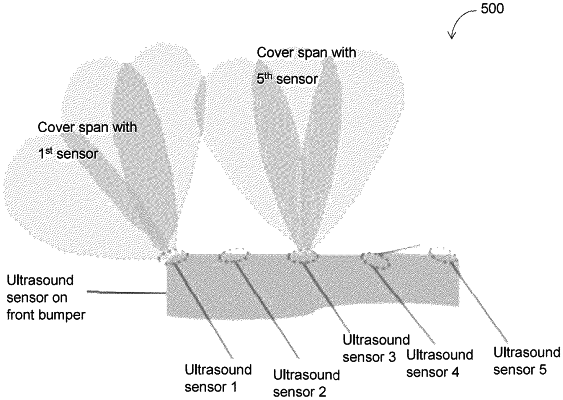| CPC B60W 60/001 (2020.02) [B60W 2420/54 (2013.01); B60W 2554/4048 (2020.02); B60W 2554/4049 (2020.02)] | 18 Claims |

|
1. A method for maneuvering an autonomous vehicle using adjustable ultrasound sensors, the method comprising:
determining, by a vehicle guiding device, at least one first position of an object relative to the autonomous vehicle using at least one high range sensor;
determining for each of the at least one first position of the object, by the vehicle guiding device, non-conformance with one or more object position criteria, wherein each of the one or more object position criteria corresponds to at least one of: position of the object relative to the autonomous vehicle and visibility of the object to the at least one high range sensor;
determining, by the vehicle guiding device, at least one second position of the object relative to the autonomous vehicle using at least one ultrasound sensor from a plurality of ultrasound sensors, when the at least one first position of the object is in non-conformance with the one or more object position criteria;
assigning in response to the determination of at least one second position, by the vehicle guiding device, at least one ultrasound sensor from the plurality of ultrasound sensors to dynamically focus on the object to determine at least one object attribute associated with the object,
wherein each of the plurality of ultrasound sensors is deployed on a rotatable mount, and wherein the assigned at least one ultrasound sensor is dynamically focused by rotating on the associated rotatable mount, and
wherein assigning the at least one ultrasound sensor from the plurality of ultrasound sensors comprises:
dividing an area covered by the plurality of ultrasound sensors into a plurality of grids,
wherein coverage area for each of the ultrasound sensors is indicated as a specific number of grid cells grouped in a specific dimension and a cell boundary is drawn considering the area covered by rotating a particular ultrasound sensor,
wherein dimensions of each of the plurality of grids correspond to the number of the plurality of ultrasound sensors, distribution of the plurality of ultrasound sensors on the autonomous vehicle, and vehicle dimensions;
identifying at least one overlapping region covered under two adjacent ultrasound sensors, wherein the at least one overlapping region comprises a common subset of grids associated with the two adjacent ultrasound sensors,
assigning, at a first time instance, at least one first ultrasound sensor from the plurality of ultrasound sensors to the object based on at least one of: availability of the object in one of the at least one overlapping region, availability of the object in one of at least one non-overlapping region, the current position of the autonomous vehicle at the first time instance, and a current assignment of each of the plurality of ultrasound sensors; and
maneuvering, by the vehicle guiding device, the autonomous vehicle on a trajectory plan based on the at least one object attribute.
|